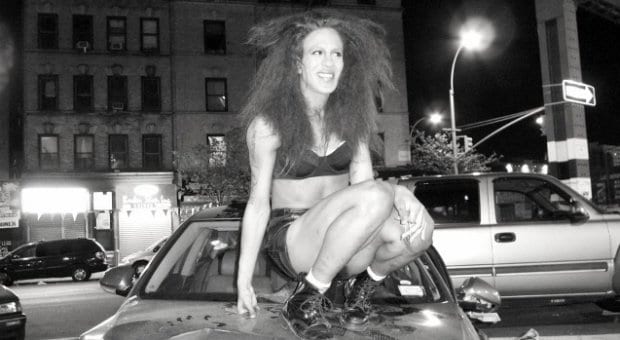Michael Quattlebaum Jr is a frequently misunderstood artist. His stage persona, Mykki Blanco, is not an alter ego but rather “a manifestation” of a “high-end, feminine, exaggerated self.” And just because Quattlebaum performs as Blanco doesn’t mean he is trans.
“I’m a gay guy,” Quattlebaum, 26, says, laughing at the widely believed misconception. “With me, there is always this element of something that’s not supposed to be, so people — gay and straight — are always getting confused by something that is really simple. I’m just a gay boy who does drag.”
Years before Quattlebaum developed his assailing female persona, the Raleigh, North Carolina, native was a unique teen who fervently consumed biographies of fringe artists. Acing algebra was not high on Quattlebaum’s list of priorities.
“I always knew I had a different personality, and the hardest thing growing up was that I knew I had a very different moral code and very different expectations,” he says. “As a teenager, I started to prep myself for an artist’s life.”
Although he had supportive, loving parents, Quattlebaum ran away to New York City at 16 and quickly put down roots in the city’s thriving gay scene, entering go-go boy contests and rubbing elbows with the likes of Alexander McQueen. In the decade since he moved to the Big Apple, Quattlebaum says, he’s seen the once “glamorous drag culture” fizzle as the cost of living in America’s most populous city rises.
“It used to be so much more alive, and this is even before I came to New York or even ran away. It doesn’t just affect gays. It’s the fact that no artist, no younger artist, has an infrastructure. That’s why I think some of that wild, transient, transgressive gay decadence as far as theatre and drag performance and performance art has moved to other cities,” he says, adding that anyone who comes to New York now came “30 years too late.”
But Quattlebaum overcame these challenges, achieving success as a poet; his 2011 collection, From the Silence of Duchamp to the Noise of Boys, garnered critical acclaim. He says his poetic abilities directly informed his compositions.
A punk outfit branded No Fear was Quattlebaum’s first foray into music, and a Facebook-based video art project that gave birth to Ms Blanco soon followed.
“Then I was performing at underground raves, gay parties and clubs in New York City,” he says. “I began to combine the Mykki project with No Fear. It was combining all the elements at once that began to get interesting for people — combining the hip hop, the punk, the electronic, the drag — so it began to be something I could really work with.”
Blanco’s latest EP, Betty Rubble, is brash, progressive and lyrically dark.
“I like rapping over material that gives me a lot of room. I’m a very wordy rapper, and I like to have control over my hooks and my choruses,” Quattlebaum explains. “A lot of the inspiration for the tone of Betty Rubble came out of this want to continue to have a sound that is a bit dark, a bit menacing, where I can have a cohesiveness that I never had on any of my previous releases.”
As for being a queen in the rap community, Quattlebaum says he has never encountered direct homophobia, but he knows he makes some people uncomfortable. He recalls attending a party held by an older, notable rapper whose name he won’t divulge. He sensed that the rapper was uncomfortable with his presence. Rather than sulk in the shadows, he went “punk rock.”
“That made me order champagne for my friends. We stayed and partied even longer,” he says.
Quattlebaum adds that homophobia from rap fans is virtually non-existent as gay rappers cultivate their own audiences.
“I’m dealing mostly with rap fans who are coming because they like me,” he says. “Very much in the same way that Lady Gaga came on the pop landscape and all of a sudden her fans weren’t Katy Perry fans, her fans weren’t Mariah Carey fans, her fans were her fans.”
Blanco was hand-picked by Björk to appear at Bluesfest and support the Icelandic singer at her upcoming Toronto show. Quattlebaum says Bluesfest attendees can expect to see Blanco “in a big, big ball gown, shirtless with beautiful jewelled pasties, rapping her ass off, howling like a punk rocker and twirling the stage like a debutante.”
But don’t expect Blanco to look like a stereotypical queen in “hyper-glamorous drag” when she performs.
“I’m kind of enjoying more androgyny, more conceptual directions where the idea of being pretty isn’t really interesting to me as much as it used to be. I want my gay friends to know that you can still like Mykki if Mykki’s not pretty. If being pretty is why you latched on to my image, maybe you should listen to my music more, because I think there is more to just being pretty.”
Mykki Blanco with Björk and Death Grips
Sat, July 13
RBC Bluesfest Ottawa, 5pm, Bell Stage
Tues, July 16
Echo Beach, Molson Amphitheatre, Toronto, 7pm


 Why you can trust Xtra
Why you can trust Xtra


